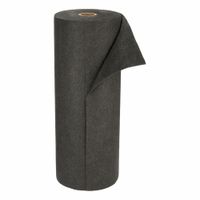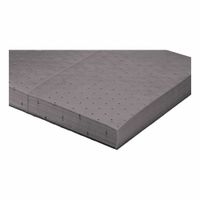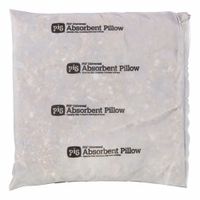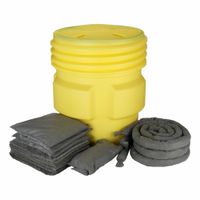Call +(254) 703 030 000 / 751 483 999 / 721 704 777
- Home
- Safety
- Sorbents Spill Control Spill Containment
- Sorbents Spill Kits
- Universal Sorbents Spill Kits
.....Read More
Frequently Asked Questions
What are universal sorbents and how do they work?
Universal sorbents are materials designed to absorb or adsorb a wide range of substances, including oils, chemicals, and water-based liquids. They are typically used in spill response and environmental cleanup operations due to their versatility and efficiency in handling diverse types of spills.
These sorbents work through two primary mechanisms: absorption and adsorption. Absorption involves the uptake of liquids into the internal structure of the sorbent material, similar to how a sponge works. Adsorption, on the other hand, involves the adhesion of liquid molecules onto the surface of the sorbent material. Universal sorbents often combine both mechanisms to maximize their effectiveness.
The materials used in universal sorbents are engineered to have high porosity and surface area, which enhances their capacity to capture and retain liquids. Common materials include polypropylene, cellulose, and various synthetic fibers, which are often treated or coated to improve their hydrophilic (water-attracting) or oleophilic (oil-attracting) properties.
Universal sorbents are available in various forms, such as pads, rolls, booms, and pillows, to suit different applications and spill scenarios. Their design allows them to be deployed quickly and efficiently, minimizing the environmental impact of spills and reducing the risk of contamination.
In summary, universal sorbents are versatile materials that effectively manage a wide range of liquid spills through absorption and adsorption. Their engineered properties and diverse forms make them essential tools in spill response and environmental protection efforts.
What is included in a universal spill kit?
A universal spill kit typically includes the following components:
1. **Absorbent Pads and Rolls**: These are used to soak up spills quickly. They are often made of polypropylene and can absorb a variety of liquids, including oils, coolants, solvents, and water-based fluids.
2. **Absorbent Socks and Booms**: These are flexible tubes filled with absorbent material, used to contain and control the spread of spills. They are placed around the spill to prevent it from spreading further.
3. **Absorbent Pillows**: These are used for larger spills or in areas where a pad or sock might not be sufficient. They can absorb a significant amount of liquid.
4. **Disposal Bags and Ties**: These are used to safely dispose of used absorbent materials. The bags are typically labeled for hazardous waste to ensure proper disposal.
5. **Personal Protective Equipment (PPE)**: This may include gloves, goggles, and aprons to protect the user from coming into contact with hazardous materials during the cleanup process.
6. **Instruction Manual**: A guide on how to use the spill kit effectively, including safety precautions and step-by-step instructions for dealing with spills.
7. **Dustpan and Brush**: For cleaning up solid materials or debris that may accompany a spill.
8. **Hazard Labels and Signs**: To mark the spill area and alert others to the potential hazard.
9. **Emergency Contact Information**: A list of contacts for reporting spills and obtaining additional assistance if needed.
10. **Container**: A durable, often portable container to store all the components of the spill kit, ensuring they are readily accessible when needed.
These components are designed to handle a wide range of non-aggressive liquid spills, making the kit versatile for various environments.
How do I choose the right universal sorbent for my needs?
1. **Identify the Type of Spill**: Determine the types of liquids you need to absorb, such as oils, chemicals, or water-based substances. Universal sorbents are designed to handle a variety of liquids, but specific needs may require specialized sorbents.
2. **Assess the Environment**: Consider where the sorbent will be used. Indoor environments may require different sorbents than outdoor settings. Also, consider factors like temperature, humidity, and potential exposure to elements.
3. **Evaluate Absorption Capacity**: Check the absorption capacity of the sorbent. This is usually measured in gallons or liters per unit. Ensure the sorbent can handle the volume of liquid you anticipate needing to absorb.
4. **Consider Material Composition**: Universal sorbents are typically made from polypropylene or cellulose. Polypropylene is more durable and suitable for a wide range of chemicals, while cellulose is biodegradable and may be preferable for environmental considerations.
5. **Check Compatibility**: Ensure the sorbent is compatible with the specific chemicals or substances you are dealing with. Some sorbents may not be suitable for highly corrosive or reactive chemicals.
6. **Review Form Factor**: Sorbents come in various forms, such as pads, rolls, socks, and pillows. Choose the form that best suits your application, whether it’s for surface spills, containment, or hard-to-reach areas.
7. **Evaluate Cost and Availability**: Consider the cost-effectiveness of the sorbent, including initial purchase price and potential disposal costs. Ensure the sorbent is readily available from suppliers.
8. **Compliance and Safety**: Ensure the sorbent meets relevant safety and environmental regulations. Check for certifications or compliance with industry standards.
9. **Test and Trial**: If possible, test a small quantity of the sorbent in your specific environment to ensure it meets your needs before committing to a larger purchase.
How do I properly dispose of used universal sorbents?
To properly dispose of used universal sorbents, follow these steps:
1. **Identify the Contaminant**: Determine the type of substance absorbed by the sorbent. This is crucial as it dictates the disposal method. Universal sorbents can absorb oils, coolants, solvents, and water-based fluids.
2. **Consult Regulations**: Check local, state, and federal regulations regarding hazardous waste disposal. The Environmental Protection Agency (EPA) and other local environmental agencies provide guidelines on handling and disposing of hazardous materials.
3. **Segregate Waste**: Separate the used sorbents based on the type of contaminant absorbed. This prevents cross-contamination and ensures compliance with disposal regulations.
4. **Contain and Label**: Place the used sorbents in appropriate containers, such as sealed bags or drums. Clearly label these containers with the type of waste and any relevant hazard warnings.
5. **Determine Hazardous Waste Status**: Conduct a waste determination to see if the used sorbents are classified as hazardous waste. This involves testing for characteristics like ignitability, corrosivity, reactivity, and toxicity.
6. **Select Disposal Method**:
- **Non-Hazardous Waste**: If the sorbents are non-hazardous, they can often be disposed of in regular trash, following local guidelines.
- **Hazardous Waste**: If classified as hazardous, arrange for disposal through a licensed hazardous waste management company. They will ensure the waste is treated, stored, or disposed of in compliance with regulations.
7. **Documentation**: Maintain records of the disposal process, including waste determinations, transport manifests, and disposal receipts. This documentation is essential for regulatory compliance and audits.
8. **Training and Safety**: Ensure that personnel handling the disposal are trained in hazardous waste management and equipped with appropriate personal protective equipment (PPE).
By following these steps, you ensure the safe and compliant disposal of used universal sorbents.
What is the difference between universal sorbent pads and rolls?
Universal sorbent pads and rolls are both used for absorbing spills, but they differ in form and application.
Universal sorbent pads are individual sheets designed for quick and easy deployment. They are ideal for small spills or for placing under leaky equipment. Their compact size allows for precise application, minimizing waste. Pads are convenient for spot cleaning and can be easily stored in spill kits or near potential spill sites for rapid response.
Universal sorbent rolls, on the other hand, are continuous lengths of absorbent material that can be cut to size. They are suitable for larger spill areas or for creating custom-sized absorbent mats. Rolls offer flexibility in coverage, allowing users to cover large surfaces or wrap around equipment. They are efficient for ongoing maintenance tasks or when dealing with frequent spills over a wide area.
Both pads and rolls are made from similar materials, typically polypropylene, and are designed to absorb a wide range of liquids, including oils, coolants, solvents, and water-based fluids. They are often used in industrial, automotive, and maintenance settings.
In summary, the primary difference lies in their form and application: pads are for targeted, smaller spills, while rolls provide customizable coverage for larger or irregular areas.
How do universal sorbent socks and booms help in spill containment?
Universal sorbent socks and booms are essential tools in spill containment, designed to manage and mitigate the spread of various liquid spills, including oils, coolants, solvents, and water-based fluids. These products are made from highly absorbent materials that can soak up a wide range of liquids, making them versatile for different spill scenarios.
Sorbent socks are flexible tubes filled with absorbent materials. They are primarily used to encircle and contain spills, preventing the liquid from spreading further. By placing these socks around the perimeter of a spill, they act as a barrier, effectively isolating the spill area. This containment is crucial in preventing the spill from reaching sensitive areas, such as drains or waterways, which could lead to environmental contamination.
Booms, on the other hand, are larger and more robust than socks. They are used for containing and absorbing larger spills, particularly in bodies of water. Booms float on the surface, creating a barrier that confines the spill to a specific area. This containment allows for easier recovery and cleanup of the spilled material. Booms are often linked together to cover larger areas, ensuring comprehensive containment.
Both socks and booms are designed for quick deployment, which is critical in emergency spill situations. Their ease of use allows responders to act swiftly, minimizing the potential damage caused by the spill. Additionally, these sorbents are often made from materials that are chemically inert, ensuring they do not react with the absorbed liquids, which could otherwise exacerbate the situation.
In summary, universal sorbent socks and booms are vital for effective spill containment, providing a rapid response solution that prevents the spread of hazardous materials, protects the environment, and facilitates efficient cleanup operations.
Are universal sorbents effective for both oil-based and water-based spills?
Universal sorbents are designed to absorb a wide range of liquids, including both oil-based and water-based spills. They are typically made from materials like polypropylene, which is oleophilic (attracts oil) and hydrophilic (attracts water), allowing them to effectively absorb different types of liquids.
For oil-based spills, universal sorbents are effective because they can absorb oils and hydrocarbons without becoming saturated with water. This makes them suitable for use in environments where oil and water may be present simultaneously, such as in industrial settings or on bodies of water. Their ability to float on water while absorbing oil is particularly advantageous in marine spill scenarios.
For water-based spills, universal sorbents can also be effective, as they are capable of absorbing aqueous solutions, chemicals, and other water-based liquids. This versatility makes them useful in a variety of situations, from chemical spills in laboratories to cleaning up water-based paints or coolants in industrial facilities.
However, while universal sorbents are effective for both types of spills, they may not always be the most efficient choice for every situation. Specialized sorbents, such as oil-only sorbents, may offer superior performance for oil spills by absorbing oil more quickly and with greater capacity, while ignoring water. Similarly, water-only sorbents might be more efficient for certain water-based spills.
In summary, universal sorbents are effective for both oil-based and water-based spills due to their ability to absorb a wide range of liquids. However, for optimal performance, especially in large-scale or specific spill scenarios, using specialized sorbents might be more advantageous.







